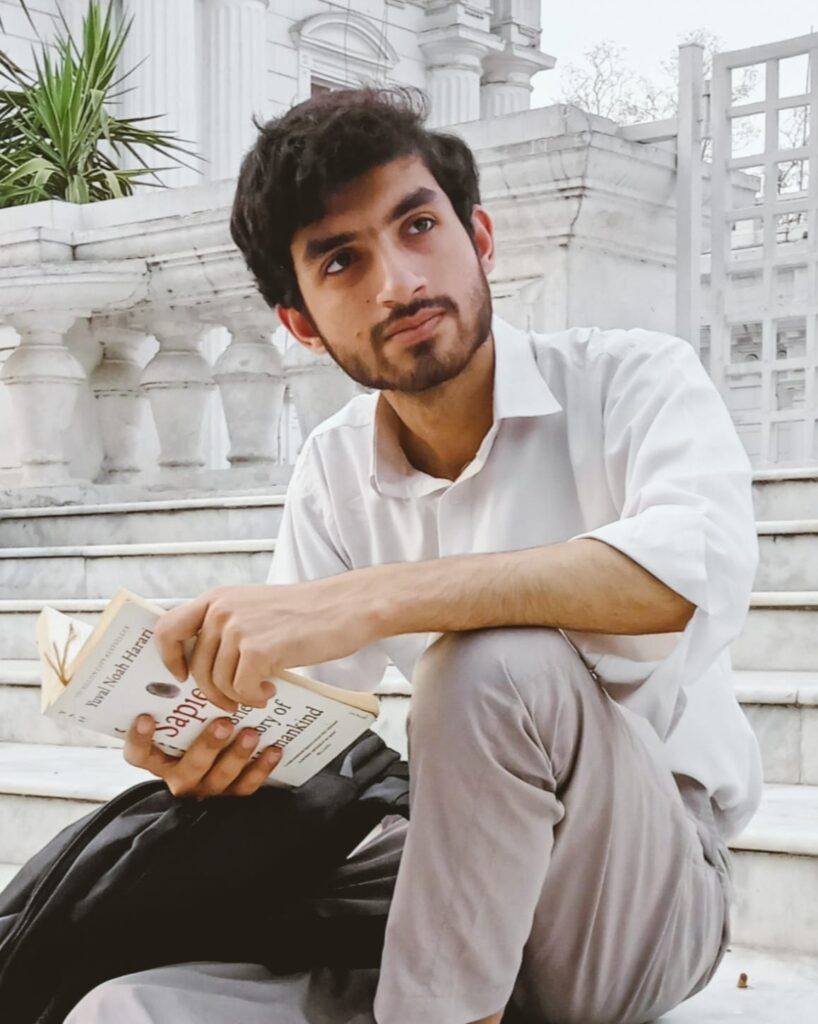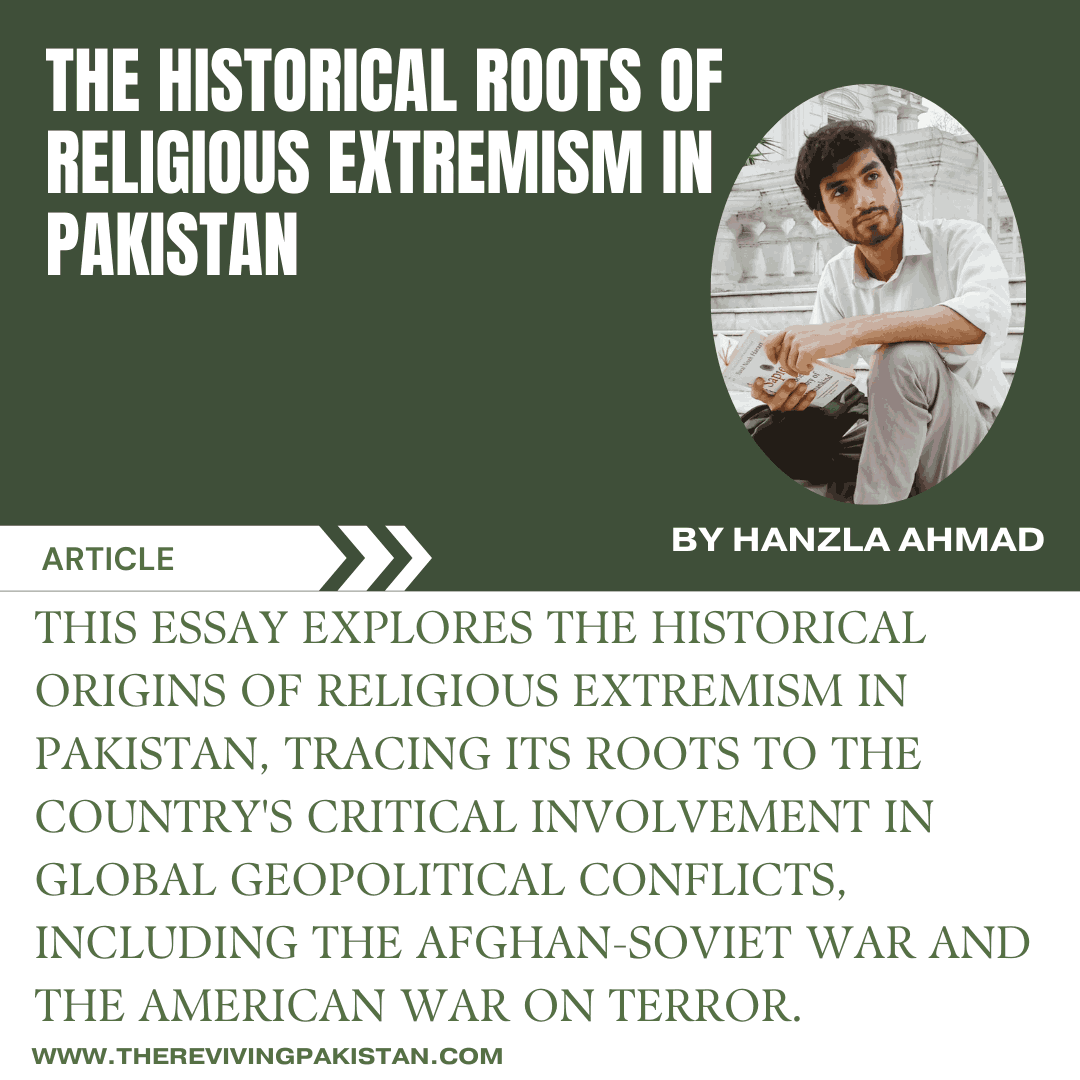About the Author(s)

Hanzla Ahmad
Author is a student of Political Science at Lahore University of Management Sciences. His passion for writing stems directly from the nature of his degree. He is particularly interested in studying the implications of the Cold War and post War on Terror politics and politics of identity in South Asia.
This essay explores the historical origins of religious extremism in Pakistan, tracing its roots to the country’s critical involvement in global geopolitical conflicts, including the Afghan-Soviet War and the American War on Terror. Contrary to the view held by some scholars, which attribute religious extremism to Pakistan’s character as an Islamic state and cite events of communal violence from the time of partition, this paper argues that the rise of religious extremism has its roots in the strategic role Pakistan played in promoting the American interests in the region. The essay goes on to show how Pakistan’s critical involvement in the US-funded Jihad against the Soviet Union not only revived the classical theological concept of Jihad in the Muslim world but also militarized religious and ethnic groupings within Pakistan. The inflow of arms, funds, and ideological support in Pakistan by the USA laid the foundations of a horrible cycle of religious extremism and violence in the country. Finally, the paper insists on strengthening democratic institutions in the country and bringing strong democratic leadership that puts the national interests of Pakistan above the hegemonic interests of global superpowers.
Religious extremism and violence became an important issue all over the world in the last quarter of the twentieth century. Interestingly, this religious extremism emerged in a century when religion was gradually giving way to secular ideologies in social, economic, and political realms worldwide. In Pakistan, this tide of religious extremism has unfolded itself in many ways. In recent times, this phenomenon has been happening at an alarming rate, causing many incidents, including mob lynching, burning of houses belonging to people of other religions, and demolishing their worship places on allegations of blasphemy.
Moreover, Pakistan has faced the worst terrorism as a form of religious extremism. The South Asia Terrorism Portal shows the number of fatalities in terrorist violence in Pakistan between the years 2000-2019 to be approximately 63,898. These terrorist attacks, suicide bombings, and massacres all happened in the name of religion. It is essential to study the historical roots of this issue to understand its dynamics and to eliminate it. Although Pakistan has a history of communal violence at the time of partition, a systematic form of religious extremism emerged as a result of Pakistan’s central role in the Afghan-Soviet War and the American War on Terror. This paper will tend to explore these historical roots in detail.
Religious extremism emerged in Pakistan in the last quarter of the 20th century when it participated in and promoted the American narrative of Jihad in Afghanistan against the communist Soviet Union. The end of the 19th and the beginning of the 20th century are marked by the increased acceptability of secular political ideologies in the Muslim world. The Ottoman Empire was abolished, and Turks struggled for their liberation “under the banner of an intemperate secularism.” The idea of Pakistan was shaped by Muslim nationalism in India, which received powerful opposition from the Indian Ulema. The same was true of the national struggles carried out in Iraq, Syria, Palestine, and Lebanon then.
In the first half of the twentieth century, there was no mass uprising in the Muslim world, which had a strictly theological pan-Islamic character. The religious movements of that time were also carried along secular lines and aimed at the reformation of Muslim minds in the increasingly secular world. Even the revivalist movements in the Indian subcontinent usually aimed at raising the status of religion as a political and economic system. The concept of Jihad as an organized armed struggle against infidelity was no longer there. In the 20th century, the term Jihad was used around the Muslim world in a political, nationalist, and very secular sense of the word until the outset of the war against the Soviet Union in Afghanistan. Here for the first time in the last century, the term Jihad was given a strictly theological meaning since it was to be launched against a “godless communism.” “The notion of jihad as ‘just struggle’ had not existed in the Muslim world since the tenth century until the United States revived it during its jihad against the Soviet Union in Afghanistan.” Had it not been for the support of the United States, the violent concept of jihad would never have gained currency in the twentieth century through the efforts of Muslim clerics alone. This jihad against the Soviet Union, funded by the CIA, supported by Western powers, and glorified by United States media, resurfaced the Medieval concept of Jihad in Muslim imagination and planted the seeds of extremism in the region.
Though the Afghan jihad affected most of the Muslim world, Pakistan played a central role in this war owing to its geographical importance. At that time, Pakistan and Iran were two independent Muslim states sharing borders with Afghanistan. However, by then, the US-favoured Shah regime had fallen in Iran, and Khomeini’s new Islamic regime was unwilling to cooperate with American interests in the region. Consequently, Pakistan became the ground to stage this final combat between capitalist America and the communist Soviet Union. To make matters worse, Pakistan did not have a democratically elected leadership in power at such a crucial time. The country was under the military regime of General Zia-ul-Haq following his coup d’état against Zulfiqar Ali Bhutto’s elected government. The immense popularity of Bhutto gave Zia a hard time gaining legitimacy as a ruler. Zia turned towards religion in search of legitimacy, and the turn of events sufficiently allowed him to do so.
The establishment of a Shia Islamic regime in neighboring Iran gave him sufficient justification and support for the establishment of a Sunni Islamic regime in Pakistan. The beginning of the Soviet war in Afghanistan gave him another ripe chance to promote his project of Islamization. Zia, backed by the CIA, advanced a strictly fundamental interpretation of Islam and Jihad in Pakistan. Pakistan opened its doors to the millions of Afghan refugees that flooded into its borders to escape the bloody war. Pakistan became the training ground for the militants or mujahideen recruited by the United States to fight in Afghanistan. “Hundreds, eventually thousands, of young Muslims from places as far apart as Algeria and the Philippines, Sudan and Sinkiang, travelled to Peshawar and Torkham, received training in the use of arms, and under the strict guidance of various Islamic parties, became ideologically ripe.” However, the phenomenon as violent as the religious extremism in Pakistan cannot be explained by the ideological shift alone; its practical side is related to the American supply of arms and funds that was poured into Pakistan at that time.
The United States pumped around 10 billion dollars in the form of arms in Pakistan and Afghanistan. The situation was such that every third man in Pakistan was armed with guns and grenades. The amount of threat this weaponization poses is beyond limits. In Afghanistan, the Taliban accumulated a handsome wealth of arms from the American supply. In Pakistan, the conventional Islamic parties such as Jamiat-e-Ulema-i-Islam and Jamiat-i-Ulema-i-Pakistan were militarized due to their connections with the Taliban. Other armed sectarian groupings, including the Sipah-i-Sahaba, Harkat-ul-Ansar, Laskar-e-Tayba, Lashkar-i-Jhangvi, Sipah-i-Mohammed, to name a few, emerged as separate militarized forces posing a serious threat to the state as well as civil society of Pakistan. This militancy and militarization of religious and sectarian groups marked the beginning of violence in the region.
During the Global War on Terror following the attacks of 9/11, Pakistan’s alliance with the United States raised extremism to unprecedented levels. With the end of the Cold War and the fall of the USSR, unipolar world order was established, and the United States emerged as the sole superpower of the world. Since no one could challenge it, the United States started its military and ideological expansion worldwide. However, this supremacy of the United States was now challenged by the Jihadists that the United States itself had created. So, when the United States tried to strengthen its hold on the Muslim lands, its concept of Jihad backfired.
The events took a 180-degree change when the Jihadists created and trained by the United States were termed terrorists. After 9/11, the United States launched a war against the Taliban in Afghanistan. Unfortunately, Pakistan did not have a democratic leadership even at this crucial point under the military rule of General Pervez Musharraf. Again, Pakistan, being its crucial ally, sided with the United States. Pakistan served as an American proxy, giving its land to the CIA to launch direct drone attacks in Afghanistan. This caused the militant groups both in Pakistan and Afghanistan to turn the faces of their guns toward Pakistani people and forces. Between 2001 and 2019, Pakistan faced severe extremism at the hands of these groups, causing nearly seventy to eighty thousand fatalities, loss of infrastructure, social unrest, and economic instability. The suicide bombings targeted every public place, from mosques and shrines to schools, parks, and resorts. An atmosphere of intolerance has been created where sectarian and ethnic conflicts have become commonplace. The religious movements have been imbibed with a militant ideology. Incidents of religious intolerance and fanaticism are happening at an alarming rate. Overall, Pakistan has faced disintegration and instability because of religious extremism.
Some scholars suggest that the religious extremism in Pakistan had its roots in the very creation of Pakistan when communal riots happened between Muslims and India. The religious character of the struggle for Pakistan and the use of religion in Pakistani politics are the causes of religious extremism. This analysis may hold some weight, but the ground realities suggest otherwise. There are Muslim countries in the world that have more strict and fundamentalist involvement of religion in politics, yet they haven’t faced religious extremism the way Pakistan did in the last two decades. Iran has an authoritative Islamic regime, with far less freedom for women than in Pakistan. Saudi Arabia is a tyranny, “the most fundamentalist in the history of Islam,” as suggested by Eqbal Ahmad, yet it does not have militant groups preying upon its people (64). Pakistan is far more secular than these countries, having a parliamentary democracy, a federal system, and a capitalist economy. The roots of the issue do not lie in the religious character of its politics but in the policies it adopted to favor the interests of a Superpower to receive aid in return.
To conclude, the historical roots of religious extremism in Pakistan do not lie in its struggle or the character of its politics. This issue stems from Pakistan’s central role in the United States’ policies regarding Afghanistan. The United States promoted Jihad in Afghanistan, poured arms and funds into Pakistan, trained the militants, and militarized religious parties. Sectarian and ethnic groupings took arms against each other, against the state, and against the people of Pakistan. Pakistan’s alliance with the United States during the War on Terror pushed it into a decades-long cycle of violence and hatred. Pakistan needs popular democratic leadership who represents the interest of the people, not military dictators who side with the interests of global superpowers.

